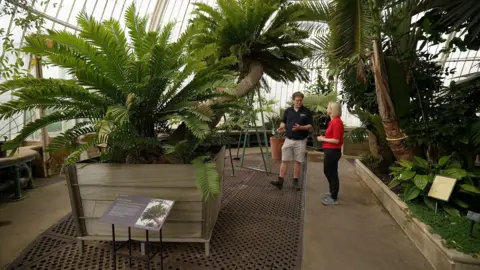Kew Gardens’ iconic Palm House is set to undergo a significant transformation, with plans to close it for an extensive five-year renovation starting in 2027. This ambitious project, estimated at £50 million, aims to enhance not only the structural integrity of the Palm House, which has been deteriorating since its opening in 1848 but also to achieve net-zero emissions from the iconic glasshouse, a crucial step in addressing climate change.
The Palm House is known for housing a diverse collection of tropical plants within a unique glass and iron structure, reminiscent of engineering marvels of the Victorian era. The building’s delicate ecosystem has faced challenges due to the intense heat and humidity required for the plants, leading to significant wear and tear over the decades. The restoration will involve moving approximately 1,300 plants, replacing over 16,000 panes of glass, and addressing the vital structural components such as hundreds of tonnes of iron that have succumbed to rust.
As work progresses, Kew Gardens has already begun the planning process, submitting the necessary permissions and initiating the delicate task of relocating the diverse plant specimens housed inside the Palm House. Among these, one of the most challenging plants to move is *Encephalartos altensteinii*, a 250-year-old cycad that exceeds one tonne in weight and stands approximately four meters tall. Thomas Pickering, the head of glasshouses at Kew, expressed concern over moving this remarkable specimen, emphasizing its considerable weight and fragility.
The renovation process will not only enhance the Palm House’s longevity but will also incorporate advanced technology aimed at sustainability. Kew’s team will focus on improving the insulation of the building by replacing the single-glazed panes with more effective alternatives to reduce energy consumption, which often spikes to maintain an ideal temperature of 21°C. They plan to decrease reliance on gas boilers by installing air source and water source heat pumps to better manage heating while reducing carbon emissions.
Rachel Purdon, Kew’s head of sustainability, noted that this project is a formidable challenge, particularly in balancing structural improvements and aesthetic integrity. She highlighted the importance of insulation and upgraded heating systems in significantly cutting the carbon footprint of Palm House while preserving its historical charm. Additionally, the adjacent Water Lily House will also undergo renovations during the project’s timeframe.
Kew Gardens anticipates that, while the renovations will temporarily affect visitor access, the long-term benefits will justify the investment. The staff is committed to ensuring that the restoration allows the structure to endure for future generations, minimizing the need for further refurbishments in the years to come. They are well aware of the historical significance of the Palm House, noting that it represented a considerable engineering achievement of its time, blending techniques from the shipping industry with botanical needs to create a nurturing environment for exotic flora.
This careful restoration marks a noteworthy chapter in Kew’s commitment to preserving its botanical marvels, continuing its legacy of education, conservation, and inspiration. Visitors will still have the opportunity to explore both the Palm House and the Water Lily House in the two-year period leading up to the closure, during which Kew hopes to raise awareness about the importance of sustainability and heritage conservation in the context of climate change.











